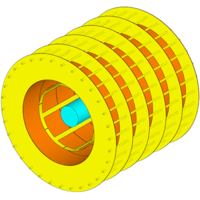当前位置:
X-MOL 学术
›
Phys. Rev. Appl.
›
论文详情
Our official English website, www.x-mol.net, welcomes your feedback! (Note: you will need to create a separate account there.)
Constructive Near-Field Interference Effect in a Birdcage MRI Coil with an Artificial Magnetic Shield
Physical Review Applied ( IF 3.8 ) Pub Date : 2020-06-02 , DOI: 10.1103/physrevapplied.13.064004 K. Lezhennikova , R. Abdeddaim , A. Hurshkainen , A. Vignaud , M. Dubois , P. Jomin , D. Berrahou , A. Raaijmakers , N. Avdievich , I. Melchakova , S. Enoch , P. Belov , C. Simovski , S. Glybovski
Physical Review Applied ( IF 3.8 ) Pub Date : 2020-06-02 , DOI: 10.1103/physrevapplied.13.064004 K. Lezhennikova , R. Abdeddaim , A. Hurshkainen , A. Vignaud , M. Dubois , P. Jomin , D. Berrahou , A. Raaijmakers , N. Avdievich , I. Melchakova , S. Enoch , P. Belov , C. Simovski , S. Glybovski

|
Radio-frequency (rf) coils are used in all clinical and research magnetic-resonance-imaging (MRI) systems to excite nuclear spins and to receive signals from them. The quality of imaging depends strongly on the signal-to-noise ratio (SNR) and the transmit efficiency of the coils. The birdcage volume coils used in most MRI scanners for homogeneous imaging of a sample are typically shielded from the external systems of the MRI scanner, i.e., the gradient coils, to confine the rf field within the region of interest. However, the near magnetic field of a conventional copper rf shield surrounding a birdcage coil interferes destructively with the primary field of the coil in the sample, which significantly limits the SNR and the transmit efficiency. In the work presented here, we theoretically study and experimentally demonstrate the possibility of creating an artificial magnetic rf shield for a birdcage coil with constructive interference in a sample. This effect is similar to the in-phase reflection of antenna far fields from a magnetic shield but affects the near field in MRI. We build an analytical model of a birdcage coil shielded with a cylindrical impedance boundary and analyze the conditions for increasing the efficiency of the coil by means of the shield. We conclude that by replacing a copper shield with an artificial magnetic one, it is possible to reduce the dissipative intrinsic losses of the coil and increase the power absorbed by the sample, which improves the efficiency. To demonstrate the effect, we perform a detailed numerical simulation and an experiment with a small birdcage in a 7-T MRI system with a magnetic shield implemented as a periodic cylindrical metal structure with corrugations filled with a ceramic.
中文翻译:

带有人工电磁屏蔽的鸟笼MRI线圈中的相长近场干扰效应
射频(rf)线圈用于所有临床和研究的磁共振成像(MRI)系统中,以激发核自旋并从中接收信号。成像质量在很大程度上取决于信噪比(SNR)和线圈的传输效率。大多数MRI扫描仪中用于样品均匀成像的鸟笼体积线圈通常与MRI扫描仪的外部系统(即梯度线圈)屏蔽开,以将rf场限制在目标区域内。但是,包围鸟笼线圈的常规铜射频屏蔽罩的近磁场会破坏性地干扰样品中线圈的主磁场,从而极大地限制了SNR和发射效率。在这里介绍的工作中,我们在理论上进行研究并通过实验证明了为样品中具有建设性干扰的鸟笼线圈创建人造射频屏蔽的可能性。这种效果类似于天线的远场从电磁屏蔽的同相反射,但是会影响MRI中的近场。我们建立了一个带有圆柱形阻抗边界的鸟笼线圈的分析模型,并通过屏蔽来分析提高线圈效率的条件。我们得出的结论是,通过用人造电磁屏蔽罩代替铜屏蔽罩,可以减少线圈的耗散固有损耗并增加样品吸收的功率,从而提高了效率。为了证明这种效果,我们进行了详细的数值模拟,并在7-T上用小型鸟笼进行了实验 这种效果类似于天线的远场从电磁屏蔽的同相反射,但是会影响MRI中的近场。我们建立了一个带有圆柱形阻抗边界的鸟笼线圈的分析模型,并通过屏蔽来分析提高线圈效率的条件。我们得出的结论是,通过用人造电磁屏蔽罩代替铜屏蔽罩,可以减少线圈的耗散固有损耗并增加样品吸收的功率,从而提高了效率。为了证明这种效果,我们进行了详细的数值模拟,并在7-T上用小型鸟笼进行了实验 这种效果类似于天线的远场从电磁屏蔽的同相反射,但是会影响MRI中的近场。我们建立了一个带有圆柱形阻抗边界的鸟笼线圈的分析模型,并通过屏蔽来分析提高线圈效率的条件。我们得出的结论是,通过用人造电磁屏蔽罩代替铜屏蔽罩,可以减少线圈的耗散固有损耗并增加样品吸收的功率,从而提高了效率。为了证明这种效果,我们进行了详细的数值模拟,并在7-T上用小型鸟笼进行了实验 我们建立了一个带有圆柱形阻抗边界的鸟笼线圈的分析模型,并通过屏蔽来分析提高线圈效率的条件。我们得出的结论是,通过用人造电磁屏蔽罩代替铜屏蔽罩,可以减少线圈的耗散固有损耗并增加样品吸收的功率,从而提高了效率。为了证明这种效果,我们进行了详细的数值模拟,并在7-T上用小型鸟笼进行了实验 我们建立了一个带有圆柱形阻抗边界的鸟笼线圈的分析模型,并通过屏蔽来分析提高线圈效率的条件。我们得出的结论是,通过用人造电磁屏蔽罩代替铜屏蔽罩,可以减少线圈的耗散固有损耗并增加样品吸收的功率,从而提高了效率。为了证明这种效果,我们进行了详细的数值模拟,并在7-T上用小型鸟笼进行了实验 带有磁屏蔽层的MRI系统,该屏蔽层实现为周期性的圆柱金属结构,波纹填充有陶瓷。
更新日期:2020-06-02
中文翻译:

带有人工电磁屏蔽的鸟笼MRI线圈中的相长近场干扰效应
射频(rf)线圈用于所有临床和研究的磁共振成像(MRI)系统中,以激发核自旋并从中接收信号。成像质量在很大程度上取决于信噪比(SNR)和线圈的传输效率。大多数MRI扫描仪中用于样品均匀成像的鸟笼体积线圈通常与MRI扫描仪的外部系统(即梯度线圈)屏蔽开,以将rf场限制在目标区域内。但是,包围鸟笼线圈的常规铜射频屏蔽罩的近磁场会破坏性地干扰样品中线圈的主磁场,从而极大地限制了SNR和发射效率。在这里介绍的工作中,我们在理论上进行研究并通过实验证明了为样品中具有建设性干扰的鸟笼线圈创建人造射频屏蔽的可能性。这种效果类似于天线的远场从电磁屏蔽的同相反射,但是会影响MRI中的近场。我们建立了一个带有圆柱形阻抗边界的鸟笼线圈的分析模型,并通过屏蔽来分析提高线圈效率的条件。我们得出的结论是,通过用人造电磁屏蔽罩代替铜屏蔽罩,可以减少线圈的耗散固有损耗并增加样品吸收的功率,从而提高了效率。为了证明这种效果,我们进行了详细的数值模拟,并在7-T上用小型鸟笼进行了实验 这种效果类似于天线的远场从电磁屏蔽的同相反射,但是会影响MRI中的近场。我们建立了一个带有圆柱形阻抗边界的鸟笼线圈的分析模型,并通过屏蔽来分析提高线圈效率的条件。我们得出的结论是,通过用人造电磁屏蔽罩代替铜屏蔽罩,可以减少线圈的耗散固有损耗并增加样品吸收的功率,从而提高了效率。为了证明这种效果,我们进行了详细的数值模拟,并在7-T上用小型鸟笼进行了实验 这种效果类似于天线的远场从电磁屏蔽的同相反射,但是会影响MRI中的近场。我们建立了一个带有圆柱形阻抗边界的鸟笼线圈的分析模型,并通过屏蔽来分析提高线圈效率的条件。我们得出的结论是,通过用人造电磁屏蔽罩代替铜屏蔽罩,可以减少线圈的耗散固有损耗并增加样品吸收的功率,从而提高了效率。为了证明这种效果,我们进行了详细的数值模拟,并在7-T上用小型鸟笼进行了实验 我们建立了一个带有圆柱形阻抗边界的鸟笼线圈的分析模型,并通过屏蔽来分析提高线圈效率的条件。我们得出的结论是,通过用人造电磁屏蔽罩代替铜屏蔽罩,可以减少线圈的耗散固有损耗并增加样品吸收的功率,从而提高了效率。为了证明这种效果,我们进行了详细的数值模拟,并在7-T上用小型鸟笼进行了实验 我们建立了一个带有圆柱形阻抗边界的鸟笼线圈的分析模型,并通过屏蔽来分析提高线圈效率的条件。我们得出的结论是,通过用人造电磁屏蔽罩代替铜屏蔽罩,可以减少线圈的耗散固有损耗并增加样品吸收的功率,从而提高了效率。为了证明这种效果,我们进行了详细的数值模拟,并在7-T上用小型鸟笼进行了实验 带有磁屏蔽层的MRI系统,该屏蔽层实现为周期性的圆柱金属结构,波纹填充有陶瓷。












































 京公网安备 11010802027423号
京公网安备 11010802027423号